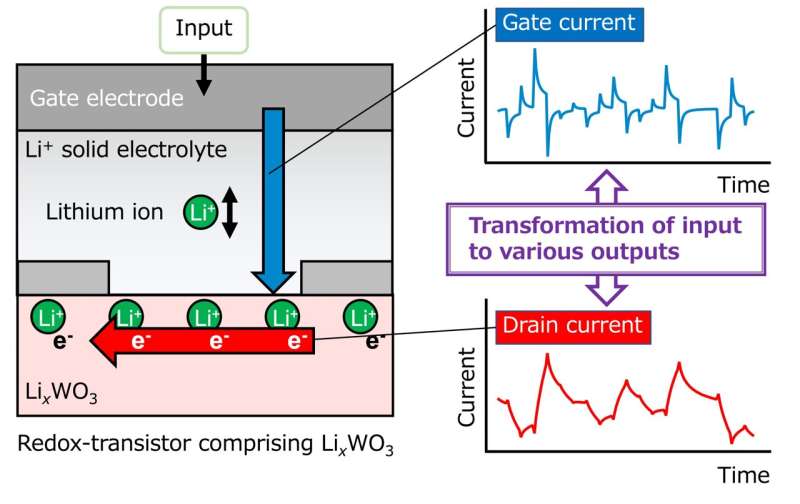Researchers develop a redox-based transistor as a reservoir system for neuromorphic computing

Physical systems known as “reservoirs” are designed to emulate neural networks and meet the need for improved computational efficiency and speed. Overcoming the previous issues with compatibility, performance, and integration of such reservoir systems, researchers from Japan have recently developed an ion-gating transistor with improved reservoir states and short-term memory capabilities based on redox reactions. This development opens us the possibility of utilizing redox-based ionic devices for high-performance neuromorphic computing.
With major breakthroughs in artificial intelligence, image recognition, and object detection, the field of computing has witnessed a remarkable revolution in recent times. Being a data-driven field, the efficient analysis and processing of large and complex datasets is of utmost importance in computing. To enhance the efficiency and speed of data-driven tasks, researchers are exploring the possibility of recognizing complex patterns and relationships inherent in the data for the development of high-performance “neuromorphic” computing technology.
This cutting-edge approach aims to replicate the brain’s ability to process information in a parallel and interconnected manner. By doing so, it seeks to construct a network of nodes capable of transforming data into high-dimensional representations suitable for complex tasks like pattern recognition, prediction, and classification.
Physical reservoirs resembling neural networks receive and interact with input signals or data, and their constituent elements, namely neurons and their interconnections, dynamically change over time. These reservoir states represent the physical system at a specific point and play a vital role in transforming input signals into high-dimensional representations. Securing the high dimensionality of a physical reservoir to achieve a sufficiently large number of reservoir states is, however, a challenging task.
Now, in a study published in the journal Advanced Intelligent Systems, researchers from Japan led by Associate Professor Tohru Higuchi at Tokyo University of Science (TUS) have developed a redox reaction-based ion-gating reservoir (redox-IGR) that can achieve a record-high number of reservoir states. With this development, Dr. Higuchi, along with Mr. Tomoki Wada and Mr. Daiki Nishioka from TUS, and Dr. Takashi Tsuchiya and Dr. Kazuya Terabe from National Institute for Materials Science (NIMS), Japan, have now advanced the possibility of translating higher-performance neuromorphic computing technology into a reality.
Ion-gating reservoirs consist of gate, drain, and source electrodes and are separated by an electrolyte that acts as a medium to control the flow of ions. Applying a voltage to the gate electrode triggers a redox reaction within the channel connecting the source and drain electrodes, resulting in a drain current that can be precisely modulated. Converting the time-series datasets into gate voltages can thus allow the corresponding output currents to serve as distinct reservoir states.
In this study, the researchers used lithium (Li+) ion conducting glass ceramic (LICGC) as an electrolyte. In LICGC, the Li+ ions travel faster compared to the channel, leading to the generation of two output currents—the drain current and an additional gate current, effectively doubling the number of reservoir states.
Moreover, the different rates of ion transport in the channel and the electrolyte results in a delay in response of the drain current compared to the gate current. This delayed response enables short-term memory capabilities within the system, allowing the reservoir to retain and utilize information from past inputs, a crucial requirement for physical reservoirs.
To fabricate this device, the researchers deposited a 200-nm thick film of lithium cobalt oxide (LiCoO2) onto a 0.15-mm thick LICGC substrate. The gate electrode was composed of a thin film of Li-ion/platinum (Pt), while Pt thin films were used for the drain and source electrodes. The channel connecting the drain and source electrodes consisted of a 100-nm thick tungsten (VI) oxide (WO3) thin film.
“We have successfully reproduced electrical characteristics similar to those of neural circuits by utilizing redox reactions induced by the insertion and desorption of Li+ ions into the LixWO3 thin film,” explains Dr. Higuchi.
Demonstrating remarkable capabilities, the device achieved a total of 40 reservoir states (20 from the drain current and 20 from the gate current). It outperformed other physical reservoirs such as memristors and spin torque devices when solving second-order nonlinear dynamic equations.
Most notably, the nonlinearity, the short-term memory capabilities, and the high number of reservoir states enabled the device to make predictions with a low mean square prediction error of 0.163 in the second-order nonlinear autoregressive moving average (NARMA2) task—a benchmark test for evaluating the performance of a reservoir system in performing complex nonlinear operations and predicting the future value of a time-series input based on its past values of both input and output.
Explaining the real-life implications of this development, Dr. Higuchi concludes, “The developed system has the potential to become a general-purpose technology that will be implemented in a wide range of electronic devices including computers and cell phones in the future.”
More information:
Tomoki Wada et al, A Redox‐Based Ion‐Gating Reservoir, Utilizing Double Reservoir States in Drain and Gate Nonlinear Responses, Advanced Intelligent Systems (2023). DOI: 10.1002/aisy.202300123
Citation:
Researchers develop a redox-based transistor as a reservoir system for neuromorphic computing (2023, July 3)
retrieved 3 July 2023
from https://techxplore.com/news/2023-07-redox-based-transistor-reservoir-neuromorphic.html
This document is subject to copyright. Apart from any fair dealing for the purpose of private study or research, no
part may be reproduced without the written permission. The content is provided for information purposes only.
For all the latest Technology News Click Here
For the latest news and updates, follow us on Google News.
